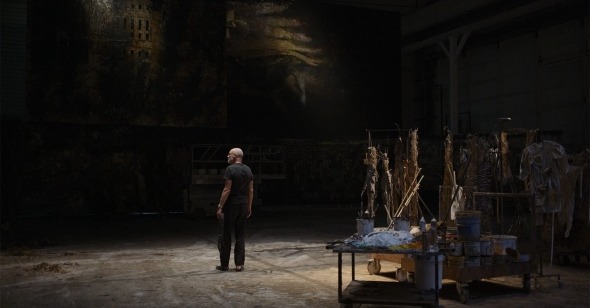Close Encounters
By Julia Gunnison
Anselm
Dir. Wim Wenders, Germany, Sideshow/Janus Films
For a period in 1991, Wim Wenders ate at the same restaurant every night. Cafe Exil in the Kreuzberg neighborhood of Berlin had been a favorite haunt for artists since the ’70s, so perhaps it’s no great surprise that the director eventually encountered visual artist Anselm Kiefer, who in the crowded restaurant one day sat down at Wenders’s table. After this first meeting, the two returned to Exil day after day to smoke, drink, eat, and talk. Life soon pulled them in different directions, but they knew that at some point in the future, they would make a film together.
You won’t learn this anecdote from Wenders’s new 3D documentary on Kiefer, Anselm. The film excludes any reference to the connection between author and subject. Their shared backgrounds—and all those long dinners—suggest a strong kinship between the artists. Born five months apart in Germany in 1945, they had similar childhood experiences, gradually discovering their country’s Nazi past amid a postwar culture of silence and forgetting. Kiefer is a highly referential artist, freely quoting writers and poets like Paul Celan, Ingeborg Bachmann, and James Joyce, pulling them into dialogue. For Wenders, however, the focus is not artistic exchange or critical exploration. Structured by the different studio spaces Kiefer inhabited throughout his career, the film provides only light biographical and historical context. Archival interviews and newsreel summarize major career milestones without much probing; for an artist who has courted as much controversy as Kiefer, the film is surprisingly placid. Two actors (Anton Wenders, Daniel Kiefer) portray Kiefer as a boy and a younger man in occasional recreations of scenes from the artist’s life. These sequences do little to interfere with the film’s main purpose: presenting Kiefer’s works. The cinematic form becomes an exhibition space, film as showroom.
Wedding dress sculptures arranged on a hilltop, lit by the rising sun streaming in from beyond the horizon; Kiefer working on a massive painting in his studio, the darkness pierced by a ghostly spotlight that illuminates his progress; the camera gliding over textured reliefs to an eerie din of whispers. Kiefer’s paintings, sculptures, and architectural pieces are physically and metaphorically huge and heavy, burdened by their weighty materials and the history they reference. War, fascism, genocide: the artworks confront the viewer with the bloody scars of the twentieth century. While in a sense, Wenders’s flourishes are in keeping with the heightened nature of Kiefer’s work, they can also be redundant: the artist’s mythic golden scythes, petrified planes, leaden beds, and concrete towers don’t require a string score to stir emotion. But Wenders stops himself before layering too much on top of his subject, and he effectively brings the viewer in thrilling proximity to the art.
Kiefer’s work is rich with mythological and spiritual symbols. He frequently references the Kabbalah and religious figures, including angels, another connection with Wenders. In an archival interview, Kiefer fields a critique that his work has turned too far from reality and toward myth. In response, Kiefer posits that “there is no such thing as escaping into myth,” as it constitutes a vital transmutation of lived experience and historical truths. Yet Wenders’s portrayal of Kiefer counters this assertion. Throughout the documentary, we see Kiefer in spaces of his own creation, mostly at Eschaton, his studio-estate in Barjac, France. He never appears in public space. As he cycles around a vast facility brimming with his artworks, there’s a feeling that we’re traveling around his own brain. With his casual mastery of the space and its contents, he resembles a god—and he practically is one. The scale of his practice would be impossible without power, wealth, and resources that few can dream of. The film shows us a Kiefer caught up by an isolated absorption in his own project. It suggests that there is such a thing as “escaping into myth:” the myth begotten by his own legendary status.
Reflecting on how Kiefer went from being persona non grata in ’80s Germany to the art world superstar he is today, art historian Andrew Renton offered a simple explanation: “He’s an extraordinary maker of stuff.” His strange, aggressive objects are relentlessly impressive. Some artist documentaries demystify their subjects, rendering their artistic process understandable or even banal. This doesn’t seem possible with Kiefer. Looking behind the curtain only intensifies the allure of his work. With a team of fabricators, Kiefer performs all manner of bizarre actions and injuries on his paintings that require blow torches, fire extinguishers, cranes, and vats of boiling water. Kiefer is most present and alive in Anselm while doing his work. He otherwise feels strangely absent. He hardly speaks, and Wenders’s direction of his movements is often palpable from behind the camera. When Wenders unites Kiefer with his 10-year-old self at the end of the film, the effect is merely puzzling. How can this move us when the film so insistently neglects the man’s character in favor of the contemplation of his art works?
Wenders’s stated hope is for the audience to “just take in the stunning scope of this great German romantic, poet, thinker, and visionary.” This goal is undeniably achieved, though there’s something disappointing in this modesty. For Wenders, 2D digital reproductions are the equivalent of “looking at a catalog”—a logic that extends to a 2D version of his own documentary. What makes Anselm exceptional is its 3D cinematography. Wenders credits 3D with enabling him to show the “aura” of Kiefer’s work, employing Walter Benjamin’s term for an artwork’s singular, ineffable presence—which the philosopher theorized that reproductions inevitably dilute. In this construction, Wenders places enormous importance on an element of the film that may not endure beyond its theatrical run; when Anselm becomes available to a wider audience through digital distribution, will we be left with just a “catalog”?
